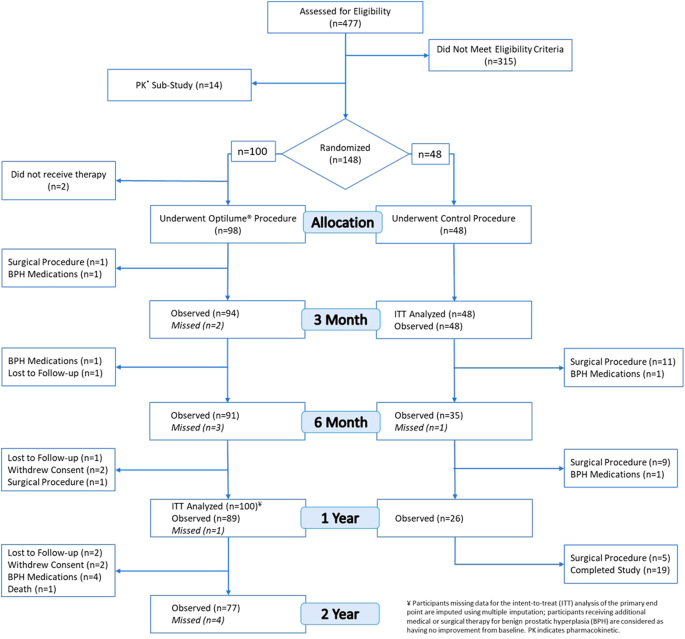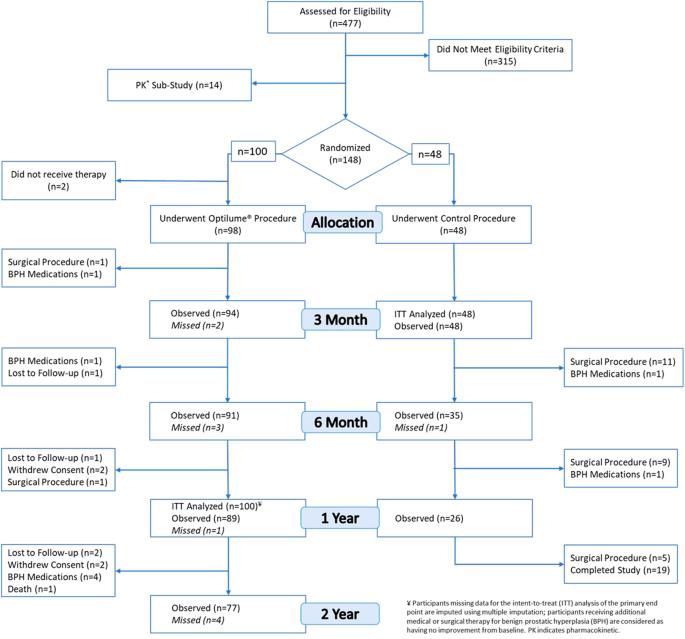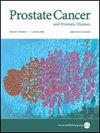在良性前列腺增生随机对照试验(PINNACLE 研究)中对 Optilume 良性前列腺增生导管系统治疗进行为期两年的长期随访
IF 5.1
2区 医学
Q1 ONCOLOGY
引用次数: 0
摘要
背景对Optilume良性前列腺增生导管系统治疗2年后的患者疗效进行了评估,该系统是一种用于治疗良性前列腺增生症(BPH)引起的下尿路症状(LUTS)的微创手术疗法。方法招募了148名有症状的良性前列腺增生症成年男性,以2:1的比例随机分配到Optilume良性前列腺增生导管系统或Sham系统(100名Optilume良性前列腺增生导管系统患者;48名Sham患者)。长期测量指标包括国际前列腺症状评分(IPSS)、峰值尿流率(Qmax)、排尿后残余尿(PVR)、生活质量指标和性功能。结果2年后,67.5%(56/83 CI 56.3%,77.4%)的Optilume良性前列腺增生症治疗组患者为症状应答者,即IPSS改善≥30%,无需药物或手术治疗。IPSS 从 23.4 ± 5.5(n = 100)明显改善到 11.0 ± 7.0(n = 74)。Qmax提高了116.8%(8.9 ± 2.2(n = 97)至19.0 ± 16.3(n = 65)),而PVR则略有下降(83.7 ± 70.3(n = 99)至65.9 ± 74.5(n = 65))。在所有前列腺体积中,尿流率测量的改善是一致的。BPH-II 从 7.0 ± 2.9(n = 98)改善到 1 年后的 2.3 ± 2.5(n = 89),2 年后保持在 2.3 ± 2.9(n = 74),改善率为 53.9%。IPSS QoL也从基线时的4.6 ± 1.3(n = 100)改善到2.2 ± 1.5(n = 74)。Optilume 良性前列腺增生治疗组最常见的不良事件是血尿和尿路感染 (UTI)。术后 12 个月内未发生与设备和/或治疗相关的严重不良事件。结论在 PINNACLE 研究中,接受 Optilume BPH 导管系统治疗的患者在 2 年后仍能获得持久的疗效,这证明了其耐受性、安全性和持久有效性。Optilume良性前列腺增生导管系统提供的持久疗效可与更具创伤性的疗法相媲美,同时保留了微创疗法的优势。本文章由计算机程序翻译,如有差异,请以英文原文为准。


Two-year long-term follow-up of treatment with the Optilume BPH catheter system in a randomized controlled trial for benign prostatic hyperplasia (The PINNACLE Study)
Patient outcomes were assessed 2 years after treatment with the Optilume BPH Catheter System, a minimally invasive surgical therapy for the treatment of lower urinary tract symptoms (LUTS) due to benign prostatic hyperplasia (BPH). One-hundred forty-eight adult males with symptomatic BPH were enrolled and randomized in a 2:1 fashion to Optilume BPH or Sham (100 Optilume BPH; 48 Sham). Long-term measures include International Prostate Symptom Score (IPSS), peak urinary flow rate (Qmax), Post-Void Residual Urine (PVR), quality of life measures and sexual function. Follow-up beyond one year was limited to those treated with Optilume BPH. At 2 years, 67.5% (56/83 CI 56.3%, 77.4%) of participants in the Optilume BPH arm were symptomatic responders as defined by ≥30% improvement in IPSS without medical or surgical retreatment. IPSS significantly improved from 23.4 ± 5.5 (n = 100) to 11.0 ± 7.0 (n = 74). Qmax improved by 116.8.% (8.9 ± 2.2 (n = 97) to 19.0 ± 16.3 (n = 65)), while PVR showed a slight reduction (83.7 ± 70.3 (n = 99) to 65.9 ± 74.5 (n = 65)). Improvement in uroflowmetry measures was consistent across all prostate volumes. BPH-II improved from 7.0 ± 2.9 (n = 98) to 2.3 ± 2.5 at 1 year (n = 89) and remained consistent at 2.3 ± 2.9 at the 2-years (n = 74), representing a 53.9% improvement. IPSS QoL also improved from 4.6 ± 1.3 (n = 100) at baseline to 2.2 ± 1.5 (n = 74). The most common adverse events reported in the Optilume BPH arm were hematuria and urinary tract infection (UTI). No device and/or treatment related serious adverse events were reported occurring beyond 12 months post-procedure. There was no impact to sexual function. In the PINNACLE study, participants treated with the Optilume BPH Catheter System demonstrated continued and durable results at 2 years, affirming tolerability, safety, and the enduring effectiveness. The Optilume BPH Catheter System provides lasting results that are comparable to the more invasive therapies, while preserving the advantages with being a minimally invasive therapy. ClinicalTrials.gov NCT04131907.
求助全文
通过发布文献求助,成功后即可免费获取论文全文。
去求助
来源期刊

Prostate Cancer and Prostatic Diseases
医学-泌尿学与肾脏学
CiteScore
10.00
自引率
6.20%
发文量
142
审稿时长
6-12 weeks
期刊介绍:
Prostate Cancer and Prostatic Diseases covers all aspects of prostatic diseases, in particular prostate cancer, the subject of intensive basic and clinical research world-wide. The journal also reports on exciting new developments being made in diagnosis, surgery, radiotherapy, drug discovery and medical management.
Prostate Cancer and Prostatic Diseases is of interest to surgeons, oncologists and clinicians treating patients and to those involved in research into diseases of the prostate. The journal covers the three main areas - prostate cancer, male LUTS and prostatitis.
Prostate Cancer and Prostatic Diseases publishes original research articles, reviews, topical comment and critical appraisals of scientific meetings and the latest books. The journal also contains a calendar of forthcoming scientific meetings. The Editors and a distinguished Editorial Board ensure that submitted articles receive fast and efficient attention and are refereed to the highest possible scientific standard. A fast track system is available for topical articles of particular significance.
 求助内容:
求助内容: 应助结果提醒方式:
应助结果提醒方式:


